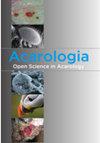Evaluation of the influence of biotic and abiotic factors on the prevalence and abundance of infestations of Mysolaelaps microspinosus (Fonseca, 1936) (Mesostigmata: Laelapidae) on Oligoryzomys longicaudatus (Bennett, 1832) in Chile
IF 0.9
3区 农林科学
Q3 ENTOMOLOGY
引用次数: 0
Abstract
The diverse biogeography of Chile provides it an ideal field to study the influence of environmental factors on plant and animal biodiversity. Some small animal species are distributed throughout dissimilar environmental zones, such as the biogeographic provinces, Mediterranean, Temperate Forest and Patagonia. One of these species is Oligoryzomys longicaudatus (Long-tailed pygmy rice rat), which is parasitized by mites of the genus Mysolaelaps (Fonseca, 1936). In this context, the present study describes the parasitic infestation rates of Mysolaelaps microspinosus on O. longicaudatus and evaluates its relationship with biotic factors (sex and host body mass) and abiotic factors (biogeographical province and season). Of 328 O. longicaudatus analyzed, 68 Mysolaelaps positive cases were obtained. Prevalence and mean abundance were 20.7% and 0.708, respectively. Multifactorial logistic and negative binomial regressions were performed to evaluate the effect of biotic and abiotic factors on prevalence and mean abundance. Both rates were significantly and directly related with biogeographic province and season, with higher rates in Mediterranean and Temperate Forest provinces and in winter and spring. The mean abundance had a significant direct relationship with host body mass, describing higher rates on heavier individuals. These results suggest that environmental factors such as temperature and food availability, strongly affect the ecology of M. microspinosus. Here we proposed that the southern limit for the genus in Chile is 47°S, mainly, due to colder temperatures. Also, biotic factors such as the weight of unpregnant hosts are relevant in parasite infestations, due to a greater parasitic load capacity by heavier individuals.生物和非生物因素对智利长尾渐殖吸虫(Bennett,1832)上微小Mysolaelaps micropinosus(Fonseca,1936)(中柱头动物:Laelapidae)感染流行率和丰度的影响评估
智利多样的生物地理学为研究环境因素对动植物生物多样性的影响提供了一个理想的领域。一些小型动物物种分布在不同的环境区,如生物地理省份、地中海、温带森林和巴塔哥尼亚。其中一种是长尾侏儒稻鼠,寄生于Mysolaelaps属的螨虫(Fonseca,1936)。在这种背景下,本研究描述了微小Mysolaelaps microspinosus对长尾藻的寄生侵扰率,并评估了其与生物因素(性别和宿主体重)和非生物因素(生物地理省和季节)的关系。在分析的328例长尾O.中,获得了68例Mysolaelaps阳性病例。患病率和平均丰度分别为20.7%和0.708。采用多因子logistic和负二项回归分析来评估生物和非生物因素对患病率和平均丰度的影响。这两种比率都与生物地理省份和季节有显著的直接关系,地中海和温带森林省份以及冬季和春季的比率更高。平均丰度与宿主体重有显著的直接关系,说明较重个体的发病率较高。这些结果表明,温度和食物可得性等环境因素强烈影响微松的生态。在这里,我们提出该属在智利的南部界限为47°S,主要是由于温度较低。此外,生物因素,如未感染宿主的重量,与寄生虫感染有关,因为较重的个体具有更大的寄生负载能力。
本文章由计算机程序翻译,如有差异,请以英文原文为准。
求助全文
约1分钟内获得全文
求助全文
来源期刊

Acarologia
ENTOMOLOGY-
CiteScore
2.00
自引率
18.20%
发文量
81
期刊介绍:
Acarologia is a free open-access journal. Please help us by submitting manuscripts in accordance with following instructions.
All manuscripts which do not conform to the instructions will be returned to authors without the benefit of review.
Acarologia publishes the results of original research on all aspects of Acarology.
The journal policy is that taxonomic descriptions should include several species within a same genus/family, when possible.
The editors reserve the right to refuse manuscripts when authors intentionally divide individual species descriptions of the same genus/family into distinct publications.
Single species descriptions should be clearly justified based on their scientific interest.
 求助内容:
求助内容: 应助结果提醒方式:
应助结果提醒方式:


